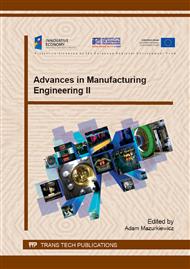p.189
p.195
p.203
p.209
p.215
p.221
p.227
p.233
p.239
The Analysis of Prototype Cast Constructions and the Assessment of their Technological and Exploitation Properties
Abstract:
The article describes the application of various methods of rapid prototyping for manufacturing of prototype castings. This technology assumes that the properties of such a casting are similar to properties of a casting obtained in serial production involving die-casting technologies or high pressure die casting. However, other conditions of metal preparation, pouring, and the solidification process, related to the specificity of manufacturing of a single casting with the application of rapid prototyping, as compared to serial production generate different final properties. Numerical simulations of exploitation conditions, with the use of Ansys and Abaqus software, were conducted for selected constructions taking into account the final properties of a casting. MAGMASoft software was used for the analysis of the technological process for manufacturing of prototype castings, as well as in serial production. The article describes the consecutive stages for manufacturing of selected prototype castings - from the moment of designing to manufacturing of a ready-made element. The selected elements were produced with the use of rapid prototyping with a 3D Z-Corp printer and a FDM Titan machine, and then model sets were prepared for casting with the application of the lost wax casting technique.The conducted analysis was aimed at defining methodology for manufacturing prototype castings with the use of numerical simulation tools, especially the implementation of boundary conditions achieved as a result of solidification analysis and techniques of rapid prototyping. It was stated that final properties of a prototype casting and a serial casting may be different, which may impact the assessment of the construction under development. The use of numerical calculations for the assessment of a prototype and serial construction with exploitation parameters broadens the expertise with final properties of the analysed construction.
Info:
Periodical:
Pages:
215-220
Citation:
Online since:
August 2015
Authors:
Price:
Сopyright:
© 2015 Trans Tech Publications Ltd. All Rights Reserved
Share:
Citation:


